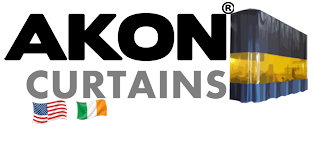9 Stronger, Smarter Alternatives to Plexiglass You Should Know
Plexiglass has been a reliable material for a long time, but that doesn't mean it's always the best choice for business needs today. As businesses become more competitive and customers expect more, many are finding that sticking to the "old standard" can keep them from moving forward. There are tons of alternative solutions in the market that can do a lot more than plexiglass can. They can make things safer and easier to see, lower maintenance costs, and make things last longer. Choosing the right thing could help your operations run more smoothly, look better, and cost less.
In this guide, we'll show you 9 useful plexiglass alternatives that are helping businesses improve their spaces, keep their employees safe, and make more money.
What Is Plexiglass?
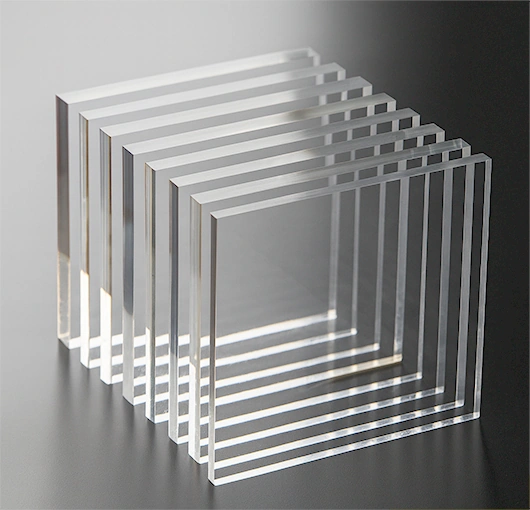
What Is Plexiglass Made Of?
Plexiglas can be created from polymers of methyl methacrylate. In it's essence, this is a plastic material. Acrylic is a transparent thermoplastic product; a synthetic polymer of methyl methacrylate. A type of plastic. Manufacturers often create it in small sheets. Ever since its development in 1928, this material has been widely used in all sorts of industrial. It has been popular for both commercial and residential purposes. Different brands have used the material to set up trademarks. Even to this day, plexiglass remains one on humanity’s great achievements. Plexiglas itself is an amazing alternative to glass. It has always been one of the most commonly used plastic materials. Unlike usual glass, it is shatter-proof, flexible, and a bit better transparency. It can, however, develop a yellow-ish color after long periods of use, and could scratch.
What Are Some Common Plexiglass Uses?
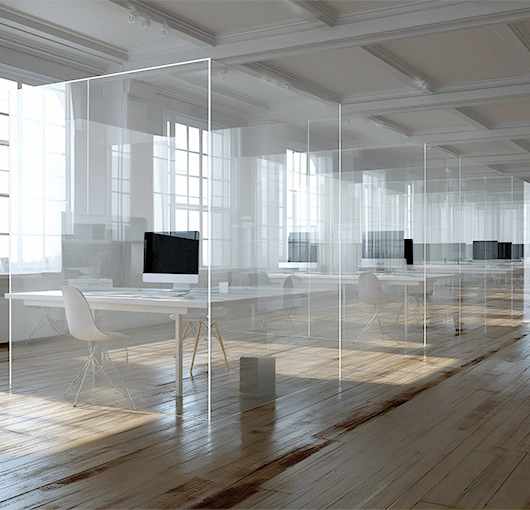
Where Plexiglass Is Used and Why You Might Want Something Better
- Checkout counters and service windows are everywhere - stores, banks, offices - but they get scratched up fast and start looking cloudy with all that daily contact.
- Office partitions and room dividers became huge during COVID, but most setups are either permanent (bad for layout changes) or flimsy temporary stuff that looks cheap.
- Security windows and tough applications use plexiglass instead of glass, but it gets that yellow, cloudy look over time, especially outdoors.
- Bathroom and shower enclosures won't shatter like glass, but harsh cleaning products and humidity can make plexiglass warp or get cloudy spots.
- Greenhouse panels and garden structures let tons of light through without breaking, but outdoor weather makes them expand, contract, and eventually look rough.
- Signs, displays, and menu boards are light and easy to cut, but they scratch easily and stop looking professional with heavy use.
- Furniture like tables and shelving gives that modern see-through look, but gets scratched up from daily use or cracks under heavy items.
The point is that plexiglass is good enough for all of these uses, but "okay" isn't always good enough. The alternatives we'll talk about next do a much better job of dealing with the problems that come up in each of these situations.
Let's look at some smart alternatives that really fix the problems people have with plexiglass, like how long it lasts, how flexible it is, how much it costs, or just how good it looks and stays looking good for years.
Alternative 1: Portable Clear Divider Screens
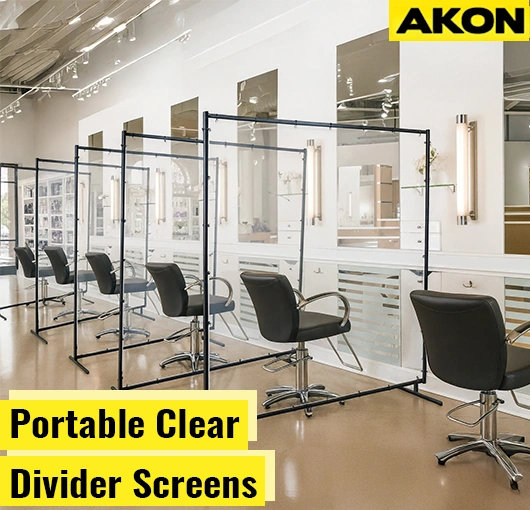
OVERVIEW
Here's the thing about regular plexiglass, once it's up, it's up. You're stuck with it. But what if you could wheel your barriers around like a shopping cart? That's exactly what portable divider screens let you do. These dividers look just as clear and professional as plexiglass, but they're built tough with strong PVC panels and lightweight frames that can handle getting bumped around in busy places without cracking or chipping like glass would. The real game-changer is being able to move them wherever you need them. When you're not using them, they fold up flat and tuck away in a storage instead of taking up permanent real estate like mounted panels. Plus, they're super easy to clean, and you can get them made to whatever height and width actually works for your space. You're basically getting a barrier system that grows and changes with your business instead of something that sits there whether you need it or not.
Alternative 2: Clear Hanging Screens
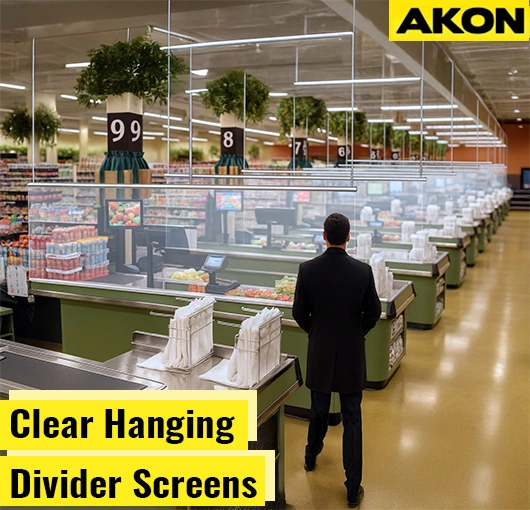
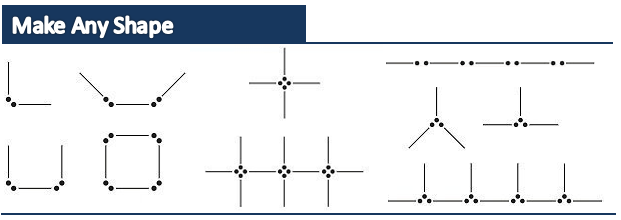
OVERVIEW
Hanging screens might be the answer if you want to make barriers quickly and easily. You don't have to drill big holes or build fancy frames to hang these clear PVC panels from the ceiling. Just use simple steel cables. Business owners love them because you can put them up in minutes. If you break one panel by accident, just replace it. You don't have to take down the whole setup. They are much cheaper to ship because they aren't heavy like glass. They are also great for places that need to change their layout often and for people who rent and can't make permanent changes. They work best at the checkout counter in a store, the reception desk at a doctor's office, an open office where you might need to move things around, or anywhere you need a barrier but don't want to feel closed in. The best thing? You don't have to stick with one layout forever. Want to switch things up next month? Unhook them and hang them back up wherever you need them.
Alternative 3: Isolation Strip Curtains
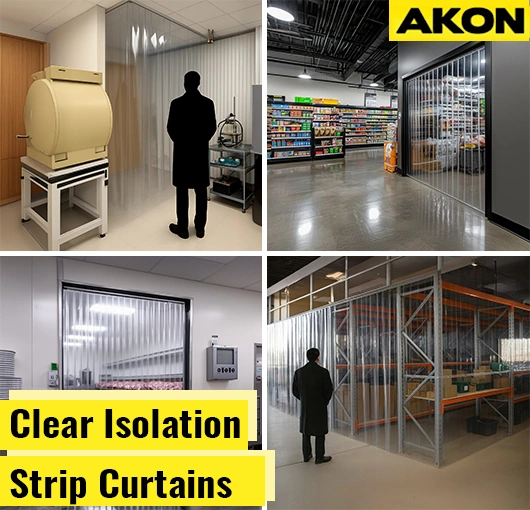
OVERVIEW
You know those plastic strips you walk through at the grocery store between the regular aisles and the cold section? That's basically what strip curtains are, except way more useful than you might think. These overlapping clear strips hang down like a beaded doorway, but instead of beads, you get thick PVC strips that you can see right through. People can just push through them with their hands full, forklifts can drive right through, and shopping carts roll through without having to open a door. That's the genius part. They automatically swing back into place after someone passes through, so you're not constantly opening and closing anything. Plus, they're surprisingly good at keeping the cold air in the cold areas and the warm air in the warm areas, which can save you real money on heating and cooling bills. They also help keep dust, bugs, and noise from traveling between areas, which is something a regular plexiglass wall can't do without making you walk all the way around to a door.
Alternative 4: Clear Isolation Curtain Rolls
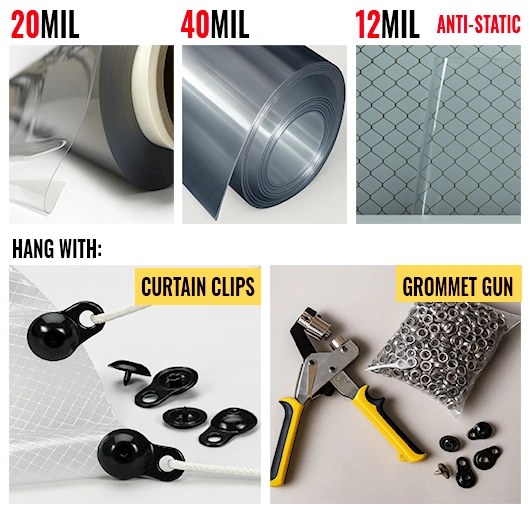
OVERVIEW
Clear PVC rolls are like the duct tape of barrier solutions; you can use them to fix or make just about anything. These are like big rolls of wrapping paper, but they are much thicker and stronger. You can cut it with regular scissors or a utility knife after you unroll it. When you need barriers up, you can have PVC roll barriers up in the time it would take just to order custom plexiglass panels. No waiting for special sizes, no heavy installation crew, no permanent mounting. Just unroll, cut, hang, and you're done. It's perfect for temporary setups, seasonal changes, or anywhere you need lots of coverage without breaking the budget.
Alternative 5: Polycarbonate Sheets
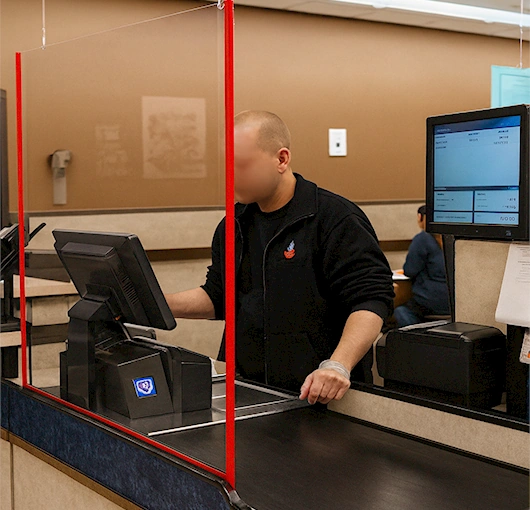
OVERVIEW
Polycarbonate is the material you need if you need something that won't easily break. It's the same material they use to make windows that won't crack and shields that protect against protests. Compare that to regular glass or even plexiglass, which would shatter or crack if someone just bumped into it wrong. They may cost more upfront than your basic plexiglass, but here's the thing - you're probably never going to replace it. Consider places where kids or large groups of people hang out, like school cafeterias, busy stores, or other places. You don't have to keep fixing or replacing broken barriers when you install polycarbonate. When you add up all the costs and trouble you won't have to deal with, the math works out pretty well. You don't have to worry about the next repair bill or safety issue all the time when you know your barriers can handle anything that comes their way. It's great for places where you need a lot of protection but still want to be able to see through your barriers.
Alternative 6: PETG Sheets

OVERVIEW
If you're constantly wiping down your barriers with disinfectants and cleaning chemicals, PETG is going to be your best friend. This solution handles all the sanitizing sprays and harsh cleaners that would make regular plexiglass crack or get cloudy over time. Think medical offices, restaurants, or daycare centers where everything gets cleaned multiple times a day. What's really nice about PETG is that it bends without snapping. It's flexible enough that you can actually work with it without worrying it will break every time you drill or cut it. Plus, if you need custom shapes or curves, PETG is way easier to heat and form than plexiglass. The flexibility thing is huge during installation too. You're not walking on eggshells worried about dropping it or hitting it wrong with a tool. It can take some abuse during setup and keep going. For places that need barriers but also need to clean everything, PETG is a great option.
Alternative 7: Tempered Glass
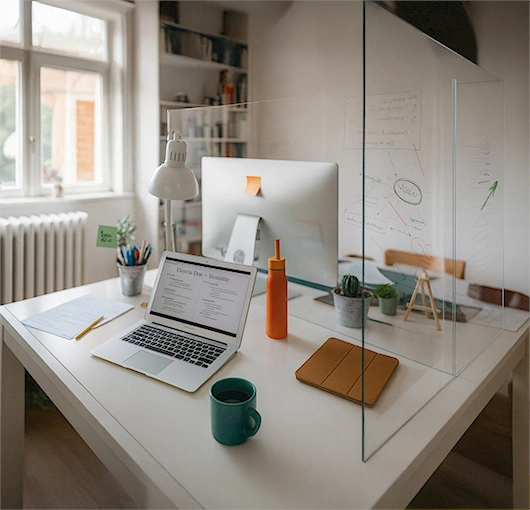
OVERVIEW
If you want your barriers to look expensive and stay that way, tempered glass is the way to go. You can find this kind of thing in fancy office buildings and high-end stores. It's crystal clear and tough as nails. Plexiglass gets yellow and scratched up after a while, but tempered glass stays looking like it did when it was new for years. It is heavier and costs more to install, but if you want that high-end look, nothing else comes close. There is no distortion, no cloudiness, and the see-through quality is just right. This is great for places where people pay attention to the little things, like high-end stores, executive offices, or anywhere you want to impress clients. The downside is that you're making a long-term promise. This won't be easy to move or change. But if you know exactly where you want your barriers and want them to look great for a long time, tempered glass is the best choice.
Alternative 8: Acoustic Panels
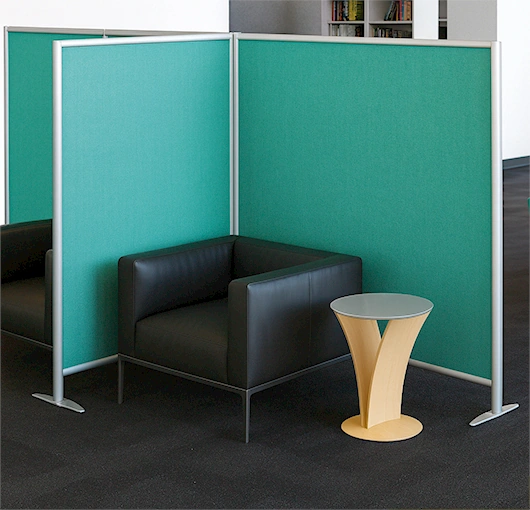
OVERVIEW
Here's something most people don't think about - regular plexiglass actually makes noise problems worse by bouncing sound around the room. Acoustic panels flip that script completely. They soak up sound while still giving you that visual separation you need. If you've ever worked in a noisy open office or busy restaurant, you know how much of a game-changer this can be. These panels work great as room dividers that actually make spaces quieter instead of just splitting them up visually. You can get them as freestanding units on wheels, mount them on walls, or even hang them from the ceiling depending on what works best for your space. They come in different colors and textures too, so you're not stuck with that clinical clear look. Instead of having conversations bounce off hard surfaces and echo around, acoustic panels grab that noise and kill it. Your space ends up feeling more private and way less chaotic. Great for call centers, open offices, or anywhere people need to concentrate but you still want some visual openness.
Alternative 9: Air Curtains
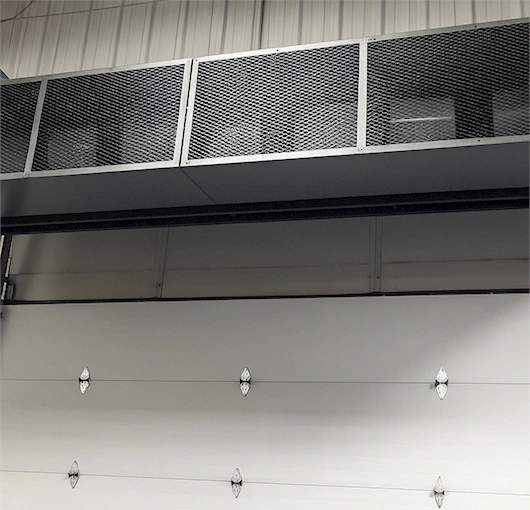
OVERVIEW
Air curtains don't use physical barriers; instead, they use flowing air to make invisible walls. You put a unit above a door or opening, and it blows a steady stream of air down like a waterfall you can't see. People and cargo can walk right through, but it keeps temperatures separate and keeps dust, bugs, and smells from moving between areas. Air curtains are great for loading docks, restaurant kitchens, or any other place where you need to separate things but can't have a physical barrier in the way. Imagine a busy kitchen where servers are always going back and forth. A regular barrier would just slow everyone down, but an air curtain keeps the dining room cool and lets people move around freely. The amount of energy saved can also be very high. The air curtain keeps most of the heated or cooled air on the right side instead of letting it all out every time someone opens a door. There is no physical barrier to cleaning, fixing, or replacing either. It's like having a bouncer for your air conditioning that never stops working and doesn't block the door.
Choosing the Right Alternative to Plexiglass
Not sure which option is best for you? This table shows the main materials, benefits, and best uses for each plexiglass alternative. Look across to see how they differ in terms of cost, durability, and mobility. This will help you choose the one that works best for your space, budget, and long-term needs.
| Solution | Core Material | Why It’s Better Than Plexiglass | Best For | Practicality |
|---|---|---|---|---|
| Portable Clear Divider Screens | PVC panels, lightweight frame | Reconfigurable and shatter-resistant; stores flat; far less brittle and easier to redeploy than rigid acrylic. | Offices, classrooms, retail, eventsGreat for seasonal or agile layouts. | High Durability High Mobility $$ |
| Clear Hanging Screens | PVC panels, steel cables | Saves floor space; panels swap individually; lighter to ship and install than plexiglass walls. | Reception counters, clinics, officesUse where overhead mounting exists. | Med-High Durability Medium Mobility $$ |
| Isolation Strip Curtains | Overlapping PVC strips | Allows traffic through while controlling airflow, temperature, dust, and noise—no doors or cutouts required. | Warehouses, factories, food processingBuilt for high-traffic zones. | High Durability Medium Mobility $$ |
| Clear Isolation Curtain Rolls | Bulk PVC (cut-to-size) | Rapid deployment and adaptable to any layout; more cost-effective per sq ft than rigid panels. | Temporary partitions, urgent installs, large coverageIdeal for fast changes. | Med-High Durability High Mobility $ |
| Polycarbonate Sheets | Polycarbonate | Far higher impact resistance than plexiglass; fewer replacements in high-abuse areas. | High-traffic/public spaces, security glazing | Very High Durability Low Mobility $$$ |
| PETG Sheets | PETG plastic | Easier to fabricate and more chemically resistant; less brittle during install/use. | Food processing, healthcare, custom shapes | High Durability Low-Med Mobility $$ |
| Tempered Glass | Safety glass (tempered) | Premium clarity and scratch resistance; won’t yellow—excellent long-term aesthetics. | Architectural partitions, premium retail, offices | Very High Durability Low Mobility $$$$ |
| Acoustic Panels | Sound-absorbing composites | Absorbs noise rather than reflecting it; improves speech privacy and focus vs. acrylic. | Open-plan offices, meeting rooms, call centers | High Durability Medium Mobility $$ |
| Air Curtains | Directed airflow system | Creates an invisible barrier that maintains climate and reduces particulates—no rigid panels or doorways needed. | Retail entrances, manufacturing, healthcare | High Durability Fixed $$$ |
Things to Consider Before Making Your Choice
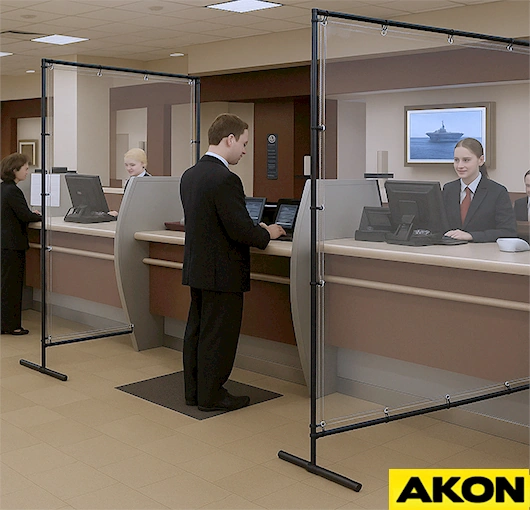
What makes these alternatives better:
- You can get them made to fit your exact space instead of trying to make standard sizes work
- They handle getting bumped and knocked around way better than brittle plexiglass
- You'll spend less money upfront, and way less on shipping since most are lighter
- They don't scratch up as easily or get that cloudy look over time
- Setting them up doesn't require a construction crew - most people can handle it themselves
- When you need to change your layout, you're not starting from scratch
- You can actually find these in stock when plexiglass is backordered for months
- Most suppliers will help you figure out exactly what you need instead of leaving you to guess
The bottom line is that these alternatives were designed to fix the problems people complain about most with plexiglass. Whether that's cost, durability, flexibility, or just being able to actually buy what you need when you need it, there's probably an option here that handles your specific situation better than the old standby.
Here's Why It's Worth Making the Switch
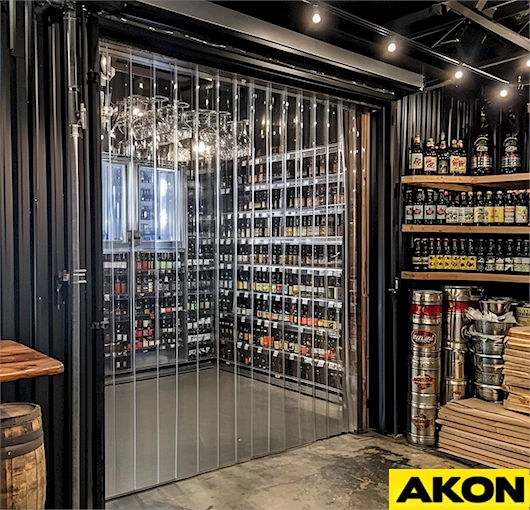
Why Switching from Plexiglass Could Be Your Best Move Yet
- Money stuff that actually matters: Stop replacing cracked panels and paying crazy shipping costs for heavy materials. Get exactly the size you need instead of buying oversized sheets that waste material. No more hiring installers every time you want changes.
- They're built to last longer: These alternatives handle daily bumps and scratches much better than regular plexiglass. No more yellowing, cracking, or beat-up looking barriers after just a few months. Your setup stays professional-looking for years.
- Extra Safety: Some don't melt and drip in fires like plastic can. Others skip the chemicals that worry some people. If you have strict safety rules or just want extra peace of mind, you've got better choices now.
- They just look better: Have you ever seen how plexiglass gets yellow and cloudy over time? These other options keep that clear, professional look for a lot longer, which is important when you want to impress customers.
- Better for the world: Some of the alternative options are recycled materials and most of them can be recycled after use as well so they are Eco-friendly alternatives.
- They actually work better for specific jobs: Instead of making one material work for everything, these are designed for your exact situation. Medical office that gets cleaned constantly? There's a perfect option. Noisy warehouse? There's something made specifically for that.
Conclusion
There is no one-size-fits-all answer when it comes to barriers. The best answer depends on what you have to deal with every day.
If you need flexibility, go with AKON's portable divider screens. They move where you need them, store flat when you don't, and won't crack when someone bumps into them with a cart. If floor space is tight, AKON's hanging screens are your answer. Quick install, easy removal, and you can replace just one panel if it gets damaged instead of redoing the whole wall. If people and equipment need to move through constantly, strip curtains are the only thing that makes sense. You get the barrier without the bottleneck. If you're covering a large area on a budget or need something fast, curtain rolls can be cut and shaped however you want on the spot.
The bottom line? Stop trying to make plexiglass work for situations it wasn't designed for. AKON's alternatives are built for real-world problems - whether that's mobility, space constraints, traffic flow, or just getting good coverage without breaking the bank. Pick the one that actually matches how your space gets used, and you'll wonder why you ever settled for rigid, fragile panels that fight against your workflow instead of working with it.
